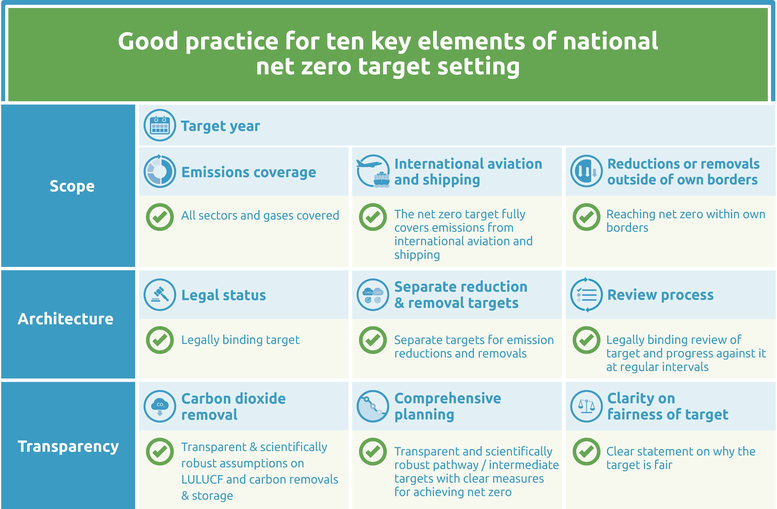Net zero targets
Summary
We evaluate the net zero target as: Poor.
New Zealand passed its Climate Change Response (Zero Carbon) Amendment Act in 2019, which sets a target for all greenhouse gases except for biogenic methane – methane from agriculture and waste – to reach net zero by 2050. There is a separate target for biogenic methane emissions to be 24-47% below 2017 levels by 2050.
The Act established an advisory body – the Climate Change Commission – that reviews and, if “significant change has occurred”, propose changes to the net zero target. Interim five-yearly emissions budgets are also mandated by the Act, which must be accompanied by supporting policies and strategies that draw on the Commission’s advice. The CCC advice to government in June 2021 recommends five year emissions budgets from 2022 to 2035 to chart New Zealand’s course to meet the 2050 targets (Climate Change Commission, 2021a). However, the accounting methods and budgets have been criticised as unlawful by LCANZI, which has taken legal action against it (LCANZI, 2021b).
While the legal architecture of New Zealand’s net zero target is relatively strong, it does not follow good practice on a number of elements. In addition to biogenic methane, international aviation, and shipping are also currently outside of the target’s scope, and the government reserves right to use of international offset credits to meet its net zero target in the case of “a significant change of circumstance”.
The transparency of the target is also poor, with unclear assumptions of the role of carbon dioxide removal or the land sector, and no clarity on how the government has assessed the target to be a fair contribution, nor on what measures and sector-specific strategies will be used to achieve the target.
CAT analysis of net zero target
Ten key elements
Scope
- Target year – New Zealand aims to reach net zero by 2050.
- Emissions coverage – New Zealand’s 2050 target is not a true net zero target as it excludes biogenic methane from agriculture and waste, which are to be reduced by 24-47% below 2017 levels by 2050. These methane emissions currently make up over 40% of New Zealand’s emissions.
- International aviation and shipping – The target excludes both international aviation and shipping. The Act obliges the Commission to provide advice on whether and how the target should be amended to include emissions from international shipping and aviation by 31 December 2024 the latest.
- Reductions or removals outside of own borders – New Zealand reserves right to use of international offset credits to meet its net zero target in the case of “a significant change of circumstance” (Government of New Zealand, 2019).
Target architecture
- Legal status – New Zealand adopted its Zero Carbon Act on 13 November 2019 (Government of New Zealand, 2019), providing a legal commitment to meet its 2050 target as well as a framework for developing policies consistent with limiting warming to 1.5°C above pre-industrial levels (New Zealand Government, 2019a). New Zealand has not yet submitted a long-term strategy to the UNFCCC.
- Separate reduction & removal targets – New Zealand does not have separate emission reduction and removal targets.
- Review process – New Zealand’s Zero Carbon Act sets up a legally binding process to review the net zero target itself and its achievability. An independent Climate Change Commission, established under the act, will review and, if necessary, propose revisions to the target. The Commission will also monitor progress towards interim five-yearly emissions budgets.
Transparency
- Carbon dioxide removal – New Zealand does not provide transparent assumptions on how the land sector and carbon dioxide removal will be used to meet its target in the Zero Carbon Act. There is a provision in the Zero Carbon Act that the Climate Change Commission may in future recommend a limit on the use of removals towards the target, but there is no such limit at present.
- Comprehensive planning – New Zealand will set interim five-year long emissions budgets, with three such budgets being in place at any one time to give a clear path over the 10-15 years ahead (New Zealand Ministry for the Environment, 2019).
Before the start of each budget period the government will need to lay out the supporting policies and strategies that will be used to meet the budget, drawing from the advice of the Climate Change Commission. The Commission recently provided its advice for the first three budget periods, which included different possible pathways for New Zealand to achieve net zero (Climate Change Commission, 2021b). The government has not yet set out concrete measures nor sector-specific targets for meeting its 2050 target. - Clarity on fairness of target – New Zealand has not provided an explanation for why its net zero target is a fair contribution to meeting the Paris Agreement’s 1.5°C limit.
Good practice
The Climate Action Tracker has defined the following good practice for all ten key elements of net zero targets. Countries can refer to this good practice to design or enhance their net zero targets.
Further analysis
Latest publications
Stay informed
Subscribe to our newsletter





